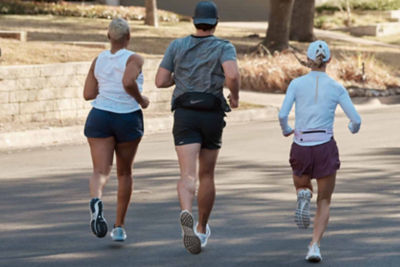Cold Weather Running Tips
The key to running in the cold is the right gear. These cold weather running tips help you navigate your winter route safely and effectively.

The winter season poses a few challenges to even the most dedicated runners — slick surfaces, icy air and protractedly dark days, for starters.
So how can you emerge race-ready for the spring season? The running devotees at DICK’S Sporting Goods have a few cold weather running tips for maintaining your momentum when the temperatures drop.
FIRST, LIGHTEN UP
We all know it’s not just the cold that deters us from running in the winter. Shorter daylight hours can not only zap motivation — they can also pose a safety threat to runners.
So, boost your visibility factor with reflective running gear. Many running jackets, shoes and tights come lined with reflective fabric, but for maximum safety you can always sport a reflective running vest. These lightweight vests (they’re usually mesh) reflect light directly back to the source — so motorists can get a better glimpse of you while you log miles.
Headlamps and wearable lights are another great way to maximize a dusk training session. In fact, most headlamps can project a few feet of light ahead, helping to provide better visibility for you and any passersby.
THEN, LAYER UP
The secret to making a winter running regimen work is all in the layers.
Start with your baselayers. Compression pieces offer minimal bulk for easy layering, but long-sleeve T-shirts and non-compression leggings can make for effective layering pieces too. Thermal baselayers use heat-seeking technology to help your body maintain critical warmth.
Then, think about a second layer, including a long-sleeve T-shirt, hoodie and/or light running jacket. You can layer loose-fitting running pants over tights in extreme cold conditions.
Even though it’s cold you’re going to sweat. Running clothes with moisture-wicking technology are key to helping you stay dry and comfortable.
LEARN TO LAYER THE RIGHT WAY
So, what should you wear when the temperatures fall? Use these guidelines to get started:
- 30 To 40 Degrees Fahrenheit: Try a long-sleeved shirt with long pants or running tights. Layer with a light jacket, fleece or sweatshirt. Lightweight gloves may be needed.
- 20 To 30 Degrees Fahrenheit: Wear a long-sleeve shirt with tights or a thermal baselayer. For extra warmth, try layering a pair of running pants over your tights. Then try a fleece top with a lightweight running jacket. You may need a hat and gloves.
- Less Than 20 Degrees Fahrenheit: Bundle up with a long-sleeve running shirt and tights. Then layer on a fleece or a sweatshirt as well as an extra pair of running pants. Zip up in a lightweight jacket. You may also want to consider wearing a hat, thick gloves (some runners wear two pairs) and a neck gaiter as well.
Discover even more tips on how to dress for winter running success.
Your personal level of comfort is key — and it may take a few tries to figure out what layers keep you feeling your best.
THINK ABOUT DETAILS
Running hats and headbands help maintain critical head warmth as you stride. Pair your headgear with a scarf or neck gaiter — keeping your neck and head warm during your run is critical.
Merino wool, fleece, knits and technical fibers that wick away moisture are all available. Running gloves and mittens are a simple way to customize your level of warmth — if you get too hot you can simply tuck them into your pockets. Plus, many of the latest winter gloves are touchscreen compatible, so you can still operate your phone or GPS watch.
Every runner needs a good pair of sunglasses. The sun’s bright glare can reflect off the snow, causing you to squint — and use up valuable energy needed for logging miles.
And don’t forget your running socks. High-cut socks can offer extra coverage from the cold. For extra thermal protection, try a wool pair.
BUNDLE UP
When it comes to layering up for the cold, it’s all in trial and error. A sweatshirt and lightweight jacket can provide excellent warmth, but in extreme conditions you may opt for a heavier jacket. Water-resistance is also key, so ensure your outerwear is designed to stand up to moisture.
Jackets can offer functional details that help you as you stride. Stash away small belongings in zippered pockets or get extra coverage from the elements with a removable hood. Running jackets should also have articulated sleeves to allow for a full range of motion.
FIND THE RIGHT SHOE
Some running shoes come with weatherized protection. Water-resistant uppers and closed-weave mesh both help keep moisture at bay, while specialized tread patterns are made to combat slippery winter surfaces. Remember, you should always select running footwear that’s appropriate for your gait type. Some cold-weather running shoes even come with fleece or a brushed thermal padding on the interior for extra warmth. If you need more help deciding, check out the DICK’S Running Shoe Finder. Answer a few quick questions about your running habits and preferred fit, and the Running Shoe Finder will point you towards the perfect pair.
KNOW THE SNOW
Snow that’s packed down can provide slightly better traction for runners. It’s also worth slowing your pace in the winter months, particularly if you’re unsure about ice surfaces.
WHEN ALL ELSE FAILS, CHANGE COURSE
If your typical running route — a park or neighborhood street, for instance — are ice-covered, winter is a great time to find a new course. If properly plowed, parking garages, business parks and parking lots can all make for a great alternative to a treadmill or indoor track.








